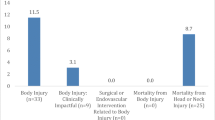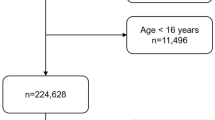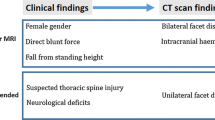Abstract
Purpose
Correlate body mass index (BMI) with incidence and type of cervical spine injury seen on CT in adult patients presenting with blunt trauma.
Materials and methods
Retrospective chart review of all adult blunt trauma patients who had a cervical spine CT performed at our level 1 trauma center during an approximately 3-year period.
Results
A statistically significant (p = 0.01) difference in cervical spine injury incidence was present between different BMI groups. Cervical spine injury incidence was 7.7% for underweight (BMI ≤ 18) patients, 7.1% for normal weight (BMI 18–25) patients, 6.2% for overweight/obese (BMI 25–35) patients, and 4.7% for morbidly obese (BMI > 35) patients. Using BMI > 18–25 as a reference group, females with BMI > 25–35 had an adjusted odds ratio (aOR) of 0.56 (CI 0.41–0.75) and females with BMI > 35 had an aOR of 0.42 (CI 0.26–0.70). Males with a BMI ≤ 18 had an aOR of 2.20 (CI 1.12–4.32) and males with BMI > 35 had an aOR of 0.66 (CI 0.46–0.95). A particularly low incidence of cervical spine injury was observed in patients older than 65 in the obese group with a cervical spine injury rate of only 1.4% in this patient population. No statistical significant difference was seen in injury morphology across the BMI groups.
Conclusion
An inverse relationship exists between BMI and the overall incidence of cervical spine injury. This protective effect appears to be influenced by gender with elevated BMI having lower relative odds of cervical spine injury in women than in men. A particularly low rate of cervical spine injury was identified in obese patients over the age of 65. Routine imaging of all elderly, obese trauma patients with low energy mechanism of injury may not be warranted.



Similar content being viewed by others
References
Ogden CL, Carroll MD, Fryar CD, Flegal KM (2015) Prevalence of obesity among adults and youth: United States, 2011-2014. NCHS Data Brief 219:1–8
Brown CV, Neville AL, Rhee P, Salim A, Velmahos GC, Demetriades D (2005) The impact of obesity on the outcomes of 1,153 critically injured blunt trauma patients. J Trauma 59(5):1048–1051
Brown CV, Neville AL, Salim A, Rhee P, Cologne K, Demetriades D (2006) The impact of obesity on severely injured children and adolescents. J Pediatr Surg 41(1):88–91
Boulanger BR, Milzman D, Mitchell K, Rodriguez A (1992) Body habitus as a predictor of injury pattern after blunt trauma. J Trauma 33(2):228–232
Dossett LA, Heffernan D, Lightfoot M, Collier B, Diaz JJ, Sawyer RG, May AK (2008) Obesity and pulmonary complications in critically injured adults. Chest 134(5):974–980
Arbabi S, Wahl WL, Hemmila MR, Kohoyda-Inlgis C, Taheri PA, Wang SC (2003) The cushion effect. J Trauma 54:1090–1093
Glance LG, Li Y, Osler TM, Mukamel DB, Dick AW (2014) Impact of obesity on mortality and complications in trauma patients. Ann Surg 259(3):576–581
Smith-Choban P, Weireter LJ, Maynes C (1991) Obesity and increased mortality in blunt trauma. J Trauma 31:1253–1257
Neville A, Brown CV, Weng J, Demetriades D, Velmahos GC (2004) Obesity is an independent risk factor for mortality in severely injured blunt trauma patients. Arch Surg 139:983–987
Beckmann N, Cai C (2017) CT characteristics of traumatic sacral fractures in association with pelvic ring injuries: correlation using the Young-Burgess classification system. Emerg Radiol 24(3):255–262
Prieto-Alhambra D, Premaor MO, Fina Aviles F, Hermosilla E, Martinez-Laguna D, Carbonell-Abella C, Nogues X, Compston JE, Diez-Perez A (2012) The association between fracture and obesity is site-dependent: a population-based study in postmenopausal women. J Bone Miner Res 27(2):294–230
Compston JE, Watts NB, Chapurlat R, Cooper C, Boonen S, Greenspan S, Pfeilschifter J, Silverman S, Diez-Perez A, Lindsay R, Saag KG, Netelenbos JC, Gahlbach S, Hooven FH, Flahive J, Adachi JD, Rossini M, Lacroix AZ, Roux C, Sambrook PN, Siris ES, Glow Investigators (2014) Obesity is not protective against fracture in postmenopausal women: GLOW. Am J Med 124(11):1043–1050
Beckmann NM, Cai C (2016) CT incidence of Morel-Lavallee lesions in patients with pelvic fractures: a 4-year experience at a level 1 trauma center. Emerg Radiol 23(6):615–621
Dennis RW, Marshall A, Deshmukh H, Bender JS, Kulvatunyou N, Lees JS, Albrecht RM (2009) Abdominal wall injuries occurring after blunt trauma: incidence and grading system. Am J Surg 197(3):413–417
Beck TJ, Petit MA, Wu G, LeBoff MS, Cauley JA, Chen Z (2009) Does obesity really make the femur stronger? BMD, geometry, and fracture incidence in the women’s health initiative-observational study. J Bone Miner Res 24(8):1369–1379
Yang S, Nguyen D, Center JR, Eisman JA, Nguyen TV (2013) Association between abdominal obesity and fracture risk: a prospective study. J Clin Endocrinol Metab 98(6):2478–2483
Pirro M, Fabbriciani G, Leli C, Callarelli L, Manfredelli MR, Fioroni C, Mannarino MR, Scarponi AM, Mannarino E (2010) High weight or body mass index increase the risk of vertebral fractures in postmenopausal osteoporotic women. J Bone Miner Metab 28(1):88–93
Kim CJ, Oh KW, Rhee EJ, Kim KH, Jo SK, Jung CH, Won JC, Park CY, Lee WY, Park SW, Kim SW (2009) Relationship between body composition and bone mineral density (BMD) in perimenopausal Korean women. Clin Endocrinol 71(1):18–26
Laslett LL, Just Nee Foley SJ, Quinn SJ, Winzenberg TM, Jones G (2012) Excess body fat is associated with higher risk of vertebral deformities in older women but not in men: a cross-sectional study. Osteoporos Int 23(1):67–74
Tanaka S, Kuroda T, Saito M, Shiraki M (2013) Overweight/obesity and underweight are both risk factors for osteoporotic fractures at different sites in Japanese postmenopausal women. Osteoporos Int 24(1):69–76
Vaccaro AR, Koerner JD, Radcliff KE, Oner FC, Reinhold M, Schnake KJ, Kandziora F, Fehlings MG, Dvorak MF, Aarabi B, Rajasekaran S, Schroeder GD, Kepler CK, Vialle LR (2016) AOSpine subaxial cervical spine injury classification system. Eur Spine J 25(7):2173–2184
Kin K, Kushida K, Yamazaki K, Okamoto S, Inoue T (1991) Bone mineral density of the spine in normal Japanese subjects using dual-energy X-ray absorptiometry: effect of obesity and menopausal status. Calcif Tissue Int 49(2):101–106
Ong T, Sahota O, Tan W, Marshall L (2014) A United Kingdom perspective on the relationship between body mass index (BMI) and bone health: a cross sectional analysis of data from the Nottingham Fracture Liaison Service. Bone 59:207–210
Felson DT, Zhang Y, Hannan MT, Anderson JJ (1993) Effects of weight and body mass index on bone mineral density in men and women: the Framingham study. J Bone Miner Res 8(5):567–573
Beck TJ, Oreskovic TL, Stone KL, Ruff CB, Ensrud K, Nevitt MC, Genant HK, Cummings SR (2001) Structural adaptation to changing skeletal load in the progression toward hip fragility: the study of osteoporotic fractures. J Bone Miner Res 16:1108–1119
Reid IR (2002) Relationships among body mass, its components, and bone. Bone 31(5):547–555
Cao JJ (2011) Effects of obesity on bone metabolism. J Orthop Surg Res 6:30
Barbour KE, Zmuda JM, Boudreau R et al (2012) The effects of adiponectin and leptin on changes in bone mineral density. Osteoporos Int 23(6):1699–1710
Reid IR (2010) Fat and bone. Arch Biochem Biophys 503(1):20–27
Compston J (2013) Obesity and bone. Curr Osteoporos Rep. 11(1):30–35
Pereira-Santos M, Costa PR, Assis AM, Santos CA, Santos DB (2015) Obesity and vitamin D deficiency: a systematic review and meta-analysis. Obes Rev 16(4):341–349
Scott D, Daly RM, Sanders KM, Ebeling PR (2015) Fall and fracture risk in sarcopenia and dynapenia with and without obesity: the role of lifestyle interventions. Curr Osteoporos Rep 13(4):235–244
Lamm S, Chidakel A, Bansal R (2016) Obesity and hypogonadism. Urol Clin North Am 43(2):239–245
De Laet C, Kanis JA, Odén A, Johanson H, Johnell O, Delmas P, Eisman JA, Kroger H, Fujiwara S, Garnero P, McCloskey EV, Mellstrom D, Melton LJ 3rd, Meunier PJ, Pols HA, Reeve J, Silman A, Tenenhouse A (2005) Body mass index as a predictor of fracture risk: a meta-analysis. Osteoporos Int 16:1330–1338
Schott AM, Cormier C, Hans D, Favier F, Hausherr E, Dargent-Molina P, Delmas PD, Ribot C, Sebert JL, Breart G, Meunier PJ (1998) How hip and whole-body bone mineral density predict hip fracture in elderly women: the EPIDOS Prospective Study. Osteoporos Int 8(3):247–254
Premaor MO, Pilbrow L, Tonkin C, Parker RA, Compston J (2010) Obesity and fractures in postmenopausal women. J Bone Miner Res 25(2):292–297
Gnudi S, Sitta E, Lisi L (2009) Relationship of bod mass index with main limb fragility fractures in postmenopausal women. J Bone Miner Metab 27(4):479–484
Nielson CM, Marshall LM, Adams AL, LeBlanc ES, Cawthon PM, Ensrud K, Stefanick ML, Barrett-Connor E, Orwoll ES, for the Osteoporotic Fractures in Men Study (MrOS) Research Group, Osteoporotic Fractures In Men Study Research Group (2011) BMI and fracture risk in older men: the osteoporotic fractures in men study. J Bone Miner Res 26(3):496–502
Bachmann KN, Bruno AG, Bredella MA, Schorr M, Lawson EA, Gill CM, Singhal V, Meenaghan E, Gerweck AV, Eddy KT, Ebrahimi S, Koman SL, Greenblatt JM, Keane RJ, Weigel T, Dechant E, Misra M, Klibanski A, Bouxsein ML, Miller KK (2016 Feb) Vertebral strength and estimated fracture risk across the BMI spectrum in women. J Bone Miner Res 31(2):281–288
Hoffman JR, Mower WR, Wolfson AB, Todd KH, Zucker MI (2000) Validity of a set of clinical criteria to rule out injury to the cervical spine in patients with blunt trauma. National Emergency X-Radiography Utilization Study Group. N Engl J Med 343(2):94–99
Stiell IG, Wells GA, Vandemheen KL, Clement CM, Lesiuk H, de Maio VJ, Laupacis A, Schull M, McKnight R, Verbeek R, Brison R, Cass D, Dreyer J, Eisenhauer MA, Greenberg GH, MacPhail I, Morrison L, Reardon M, Worthington J (2001) The Canadian C-spine rule for radiography in alert and stable trauma patients. JAMA 286(15):1841–1848
Denver D, Shetty A, Unwin D (2015) Falls and Implementation of NEXUS in the Elderly (the FINE study). J Emerg Med 49(3):294–300
Goode T, Young A, Wilson SP, Katzen J, Wolfe LG, Duane TM (2014) Evaluation of cervical spine fracture in the elderly: can we trust our physical examination? Am Surg 80(2):182–184
Acknowledgments
1. Memorial Hospital System in Houston.
2. We acknowledge the support provided by the Biostatistics/Epidemiology/Research Design (BERD) component of the Center for Clinical and Translational Sciences (CCTS) for this project. CCTS is mainly funded by a grant (UL1 TR000371) from the National Center for Advancing Translational Sciences (NCATS), awarded to University of Texas Health Science Center at Houston. The content is solely the responsibility of the authors and does not necessarily represent the official views of the NCATS.
Author information
Authors and Affiliations
Corresponding author
Ethics declarations
Conflict of interest
The authors declare that they have no conflict of interest.
Rights and permissions
About this article
Cite this article
Beckmann, N.M., Cai, C., Spence, S.C. et al. Is elevated body mass index protective against cervical spine injury in adults?. Emerg Radiol 25, 415–424 (2018). https://doi.org/10.1007/s10140-018-1602-2
Received:
Accepted:
Published:
Issue Date:
DOI: https://doi.org/10.1007/s10140-018-1602-2




